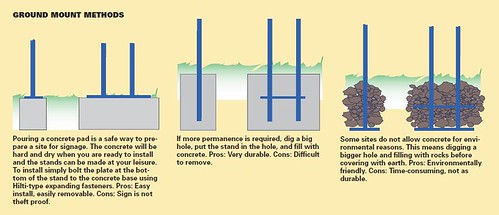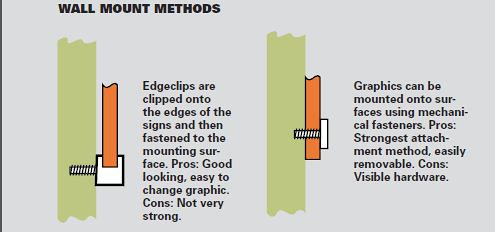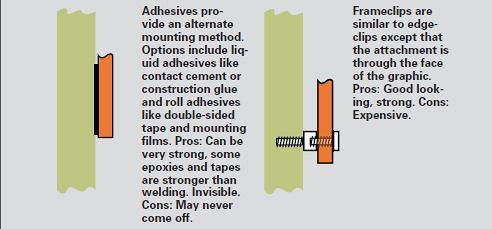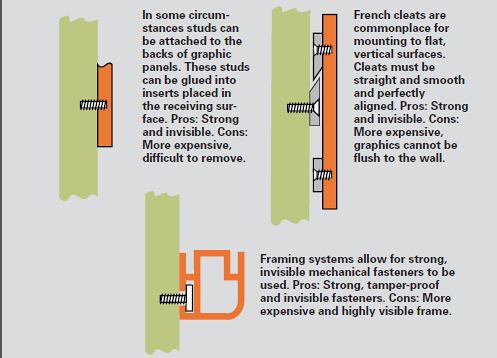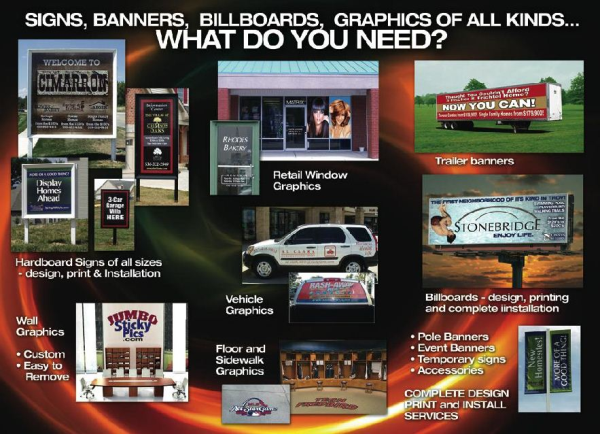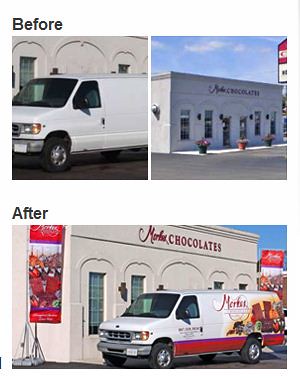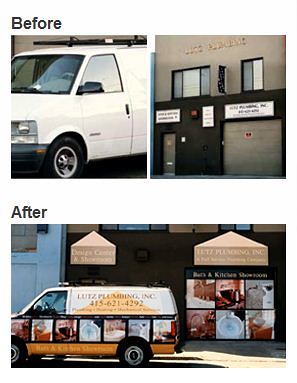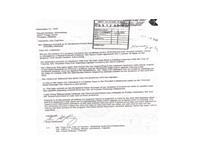Understanding the Value of Signage
There is an old axiom that the 3 keys to successfully selecting real estate are "location, location and location". The 3 keys that guide the successful selection and development of commercial properties are Visibility, Accessibility and Parking.
An effective on-premise sign is a critical component of visibility, and the sign should receive the same careful attention as these other components. Without a properly designed and placed on-premise
business sign, a commercial site cannot function at its full economic potential.
This section presents information about:
- understanding the value of signage
- determining what an effective sign will mean for your business' success
- working with and possibly correcting problems with existing signage, and
- using signage to change customer behaviors.
The Functions of the On-Premise Sign
An effective on-premise sign is a critical component of visibility, and the sign should receive the same
careful attention as these other components.
1. It develops a memory for a location and the products or services available at the location.
2. It reinforces a memory and extends recall of other advertising efforts.
3. It attracts new customers by prompting first-time or impulse visits or purchases.
4. It modifies customary purchase decisions or habits. Changeable copy and temporary window
signs are especially effective in encouraging variation from accustomed consumption patterns. (For more about modifying customary purchase habits, see the section that follows.)
Branding a Site
One measure of how effective or valuable an on-premise sign is to its site is demonstrated by how well it helps to brand the site. A sign "brands" a location, just as a product label brands the product. If an attractive image is not communicated by the business' sign, the business will rarely convey its true message, or get the clientele it seeks.
Every site development and sign program strategy will benefit if the on-premise sign is made the focal
point of the site. If a site is "signcentric", it means that the sign catches the customer's attention and leads him to the target business. A measurable positive effect on gross revenues should immediately result from:
Developing and Measuring Readership
How do you know if your sign is (or is not) branding your site for future reference by potential customers?
You determine readership.
Readership advertising effectiveness tests whether a message is effectively speaking to the intended
audience. Two of the most commonly used research techniques are the recognition and recall tests discussed above. Rating services conduct the tests and tabulate the results for all major-media
advertisers (i.e., television and newspaper advertisers rely on Nielsen Ratings Services). Small business owners not engaged in franchised or chain business operations, however, usually do not have access to national rating service readership tabulations; these independent small business owners may require the services of a local market researcher to obtain readership measures. Often, on-premise sign companies and trade associations will assist in compiling data.
Why do you want to measure readership? Without knowing the effectiveness of your signage, you won't know how well you are doing, or what you might want to change. For your greatest success - with a sign and therefore with your business - measuring readership is a diagnostic tool so you can fix whatever is not working, and increase what is working.
The importance of signage to mobile consumers is underlined by the fact that many are in a hurry. By way of example, Burger King Corporation conducted a survey over several weeks. The survey results were part of evidence submitted in a legal action brought by Burger King (among others) against Agoura Hills, California, to prevent the removal of its freeway-oriented, high rise on-premise sign as required under a new sign code. The Burger King sign was visible to the Ventura Freeway; the building was not.
Surveys were conducted at Quick Service Food (QSF), family and atmosphere restaurants. The
participants were asked how they first became aware of the restaurant. Here are the results.
How did you first become aware of this restaurant?
The spontaneous nature of the QSF visits at 35% has implications for most business strategies,
particularly advertising in the form of on-premise signage. Burger King and its co-plaintiffs won the lawsuit, and the City was permanently enjoined from enforcing its high-rise pole sign ban against them. (See, Denny's Inc., et.al. v. City of Agoura Hills, 56 Cal.App. 4th 1312, 66 Cal. Rptr 2d 382 (1997)).
In another example, The Institute of Transportation Engineers (ITE) has trip generation rates that are
derived from counts taken at the driveway of various land uses. While typical trip generation rates are
Participants' Responses Quick Service Food (% of responses) Family Restaurant (% of responses)
Atmosphere Restaurant (% of responses)
Saw it (the sign) while passing 35% 26% 13%
Always knew 29% 27% 19%
Word of mouth 14% 30% 54%
Advertising 10% 6% 4%
All other 6% 7% 7%
Don't know 6% 4% 3%
Derived from counts taken at the driveways of various land uses, not all trips generated at the driveway represent new trips made for the express purpose of entering the site; instead some are made by motorists who did not set out for the site, but who enter it as an intermediate stop on the way to or from another destination. This type of stop is referred to by the Institute of Transportation Engineers (ITE) as a "pass-by trip"; for our purposes, it is defined as an "impulse" stop.
The percentage of pass-by trips or impulse stops varies by land use. The following table sets out ITE
estimates regarding the percentage of stops attributable to motorists for whom the site is not a scheduled destination. The table demonstrates that impulse trade is very important to many businesses. Effective onpremise communication can help persuade passersby to stop and shop.
In the modern marketplace, the right place-based advertising will effectively and economically permit the local shopkeeper to compete, even with the mass merchandiser or large retailer.
Acquiring New Customers
In 1995, the California Electric Sign Association (CESA) and the International Sign Association (ISA)
commissioned a major study of on-premise signage performance by the University of San Diego. This
study had two parts.
Part I of the study involved analysis of a group of variables, including signage, location, hours of
operation, population demographics and geographic characteristics on sales at 162 southern California locations of a major fast-food chain. These variables were tested at each location to predict the impact of on-premise signage upon:
1. annual sales revenues
2. annual number of transactions
3. the average dollar amount spent per transaction.
The results of the study indicated that the number of signs at a particular site has a significant and
positive impact on both the annual sales revenues and number of annual customer transactions. For
example, from the results of the study, the researchers were able to predict:
Type of Land Use Impulse-Stop Percentages
Shopping Centers:
Larger than 400,000 sf Gross Area 20%
Between 100,000 to 400,000 sf Gross Area 25%
Smaller than 100,000 sf Gross Area 35%
Convenience Market 40%
Discount Club/Warehouse Store 20%
Fast Food Restaurant 40%
Sit Down Restaurant 15%
Service Station 45%
Supermarket 20%
1. On average, one additional on-premise sign resulted in an increase in annual sales revenues of
4.75%. This translates to a $23,750 increase in average sales revenues for a typical store in the
study group with annual sales of $500,000.
2. On average, one additional on-premise sign increased the annual number of transactions by
3.93%. This translates into more than 3,900 additional transactions for a store with an annual
average of 100,000 transactions.
3. On average, one additional 36-square-foot wall sign added $0.06 per transaction, while one
additional 144-square-foot pole sign added $0.78 per transaction.
Part II of the study involved analyzing seven years of weekly sales data for "Pier 1 Imports" to measure the effects of modifications, additions, or removal of on-premise signage on sales performance.
The results showed that "on-premise signage has a statistically significant and financially substantive
impact on the revenues of a site [and]... is a significant constituent of the factors causing the success of a retail endeavor." In brief:
1. The addition of new signage to previously unsigned buildings, and the replacement of existing
signage (generally, with larger signs) resulted in an average revenue increase of 5%.
2. The addition of a pole sign, or a plaza identity sign including the store's name, resulted in an
average increase in weekly sales of 5-10%. The increase was attributed by the researchers to the
new signs' enhancement of site visibility to passing traffic.
3. The addition of small directional signs indicating entrance and exit routes resulted in weekly sales
increases ranging from 4-12%. The increases were attributed to the signs' ability to guide a sitebound
shopper more than any specific advertising effect.
These increases in revenues, as a result of signage, demonstrate the positive effect on profitability at a
specific site, especially given that normal profits in the retail industry are approximately 1-2%.
The California Electric Sign Association (CESA), the International Sign Association (ISA), the Sign User
Council of California, and the Business Identity Council of America sponsored the study. A summary of the findings appears in The Economic Value of On-Premise Signage, a compendium of signage-related research results and articles (e.g., sign amortization; copyright and trademark protection.) The booklet was published jointly in 1997 by CESA and ISA.
Modifying Customary Purchase Habits
One of the primary goals of advertising is to change purchase behaviors. Effective advertising can
increase purchases within discrete segments of the market by introducing "intervening opportunities"
along customary travel paths. This is especially so in highly discretionary areas, such as quick service
foods and economy lodging, yet it holds true, also, for the business with more specialized products or
services to offer.
Generally, a business' fixed and variable costs should be covered from a stable consumer pool, with profits coming in from unexpected sources. The right sign often prompts an unplanned stop, or changes the customer's mind once he is on the premises. Changeable copy and temporary window signs are especially effective in encouraging variation from accustomed consumption patterns. Because temporary or variable message signage is relatively inexpensive, the dollars generated by such signage usually
represent pure profit.
It is estimated that 35-50 percent of the consumer population today shops outside their local area.
Legible, conspicuous on-premise signage will assist in attracting a large percentage of these non-local
and newcomer consumers. Further, an effective on-premise sign provides 24-hour exposure of its
message to a large pool of potential customers at a fraction of the cost (when depreciated over several
years) of other media. The lower the cost to obtain customer memory or top-of-mind awareness, the
higher the return on advertising dollars.
The Signage Appraisal Process
Like real estate, signage has a value that can actually be measured or appraised. The visibility component to a real estate site typically encompasses more than the traditional sign out front.
How is an appraisal of a sign done?
The three traditional approaches are:
1. Cost of Replacement (or Substitution). The signage appraisal method applies a cost replacement approach to determine the cost of replacing a sign's commercial communication or
advertising value with other forms of advertising, such as newspaper, television, and radio
advertisements. It is not used to measure the cost of replacing the physical structure of the sign, as
is the common measure of value in building or home appraisals.
2. Market Comparison. Generally speaking, the market recognizes premium prices for those
commercial properties with the best visibility. Outdoor advertising structures such as billboards or
bus shelters have recognized buying, selling, and leasing markets. The market sales comparison
approach as applied to the visual communication component of signage in its many forms may
measure the differentials of rents in the market. Customer surveys also may be developed, tested
and analyzed. The sales per square foot of similarly situated sites with varying levels of signage or
varying ability to be seen via the passing traffic may also be analyzed.
3. Income Flow or Capitalization. This approach is used to ascertain the present value of the
anticipated future income to be generated by a property over its remaining useful life. For the
purposes of signage appraisal, this method focuses on income generated by customers who are
prompted to stop solely by the sign. The retailer's gross retail margins are analyzed and then
capitalized.
This analysis is complicated by alternative signage forms such as business form or product franchising or chains where the system is integrated into networks of retail sites supported by national advertising (media) programs. The fundamentals of valuation and evaluation start with understanding that signs are commercial speech. Additionally signs are relied upon and used by consumers to make and influence their shopping and purchasing decisions.
Highest and Best Use Analysis
Prior to the above described three-part appraisal process, a highest and best use analysis of the site is undertaken. This analysis establishes the most profitable use of a site in light of any legal, physical or financial constraints. Highest and best use (as applied to signage) means that the on-premise sign is viewable by the intended audience (i.e., passing motorists, pedestrians), and that its copy can
communicate as it's meant to (i.e., is clearly visible, legible and understandable by the intended audience).
If you have any questions, please give us a call at The Sign Studio (818) 843-9200 or send us an e-mail at thesignstudio@sbcglobal.net
NEED QUOTE


